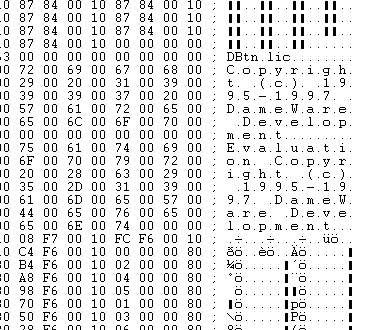Cracking Dameware Controls
Dameware Development has a unique set of simple controls that deserve a look. And they also are a good example of finding the license string for .lic files.
For this example I am using Dameware Button, a button control that provides "hover" and "click" events and that also allows you to attach sounds to those events. But the most interesting thing is not what it does as much as how easy it is to give yourself your own registered version of the control.
If you use Filemon (from www.sysinternals.com) and try to add the control to a form in Visual Basic you will see that it is looking for a file called DBtn.lic. We know by now that if the right string is in that file, then the control will think that it is a full registered version. So what is the right string to put in that file?
To find that out, open up DBtn.dll in your favorite hex editor. DBtn.dll should be located in the C:\Program Files\DameWare\DBtn directory (or wherever you installed it). If you scroll a little more than halfway through the file, you will see something very interesting:

Is that what I think it is? First of all, it refers to the license file (DBtn.lic) by name followed by two strings. The second string contains the word "Evaluation" so we know we need to stay far away from that. But look at the first one: Copyright (c) 1995-1997 DameWare Development.
Now break out your favorite text editor and put a single line of text in a blank document:
Copyright (c) 1995-1997 DameWare Development
Save that text file as DBtn.lic in the same directory as DBtn.dll and then try to put the control onto a form. No more nag screens! Now try the same same thing with every control that they make and you will see that you can very quickly own everything that they make. The funny thing is that many of their products use the same exact string we found above. The only difference is the filename.
Now not all controls that use .lic files are this easy, but there are some things to learn here that are common to many ActiveX controls:
- Many times the license string is a copyright notice
- The license string is usually a Unicode string (notice the 00 between each letter)
- You will often see a reference to the license filename or at least "lic" right before the string
- The license string is often about halfway through the file after a long portion of binary data
Again, these aren't firm rules but I have seen these common elements often enough that they are a good place to begin.
To purchase or learn more about Dameware Development, go to their web site at www.dameware.com.